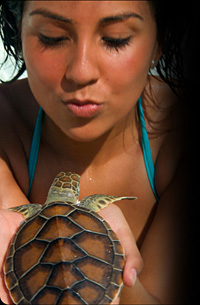
|  |  |  Travel & Outdoors | April 2009 Travel & Outdoors | April 2009  
Xcaret Ecological Park to Hatch 2,000 Turtles
 Juan David Leal - EFE Juan David Leal - EFE
go to original


| | In Mexico, since 1990, marine turtles are protected by the Federal Law. Xcaret, joining efforts with government institutions, protects the two species of turtles that nest in Quintana Roo`s beaches: the Green Turtle (Chelonia mydas) and the Loggerhead Turtle (Caretta caretta). For more info visit the website at Xcaret.com |  |
Cancun - Mexico's biggest private ecological park is expanding its already comprehensive sea turtle conservation program and will hatch a record number of them this year.

According to executives at Xcaret - a sprawling ecological park in Quintana Roo noted for its cenotes, deep limestone sinkholes with a pool at the bottom, and its large menu of activities for visitors - 2,000 baby turtles will be released as part of a breeding program the company has run for more than 10 years.

Some conservation efforts on behalf of the turtles release hatchlings into the wild only days or weeks after they are born. Xcaret's Initiation Program, however, differs greatly. With the authorization of the federal government, the company uses a special team of veterinarians to nurture the turtle hatchlings born at the two nesting sites they maintain for 15 months.

In that time, the turtles grow to be about 30 centimeters, which make them far tougher prey for predators. At that point, generally between February and March, veterinarians release the young turtles as tourists gather to watch the young reptiles make their way to the ocean.

Officials at Xcaret are hoping that the personal connection visitors get by seeing the sea turtles crawl out to sea will spur renewed interest in the center's work.

"One of the program's main goals is to raise people's awareness about the plight of marine turtles in Mexico," Ana Cecilia Negrete, coordinator of operations and preventive medicine for marine turtles in Xcaret, said.

Xcaret also functions as a sort of zoo - with 300 turtles on show - and a rehabilitation center for turtles that are hurt in the wild by natural causes and by human incursion.

Veterinarians at Xcaret are able to save 98.4 percent of the injured turtles that are brought from the wild.

The country is home to the green, hawksbill, loggerhead, white and the less common leatherback species of sea turtles. All of them are in grave danger of extinction, according to officials at the center.

At nesting season in the Riviera Maya, about 6,000 nests can be found.

The principal dangers to Mexico's turtles include the invasion of their habitat, sport fishing, people who eat their flesh and eggs, and injuries to some of them by outboard motors on boats. |

 |
|  |



